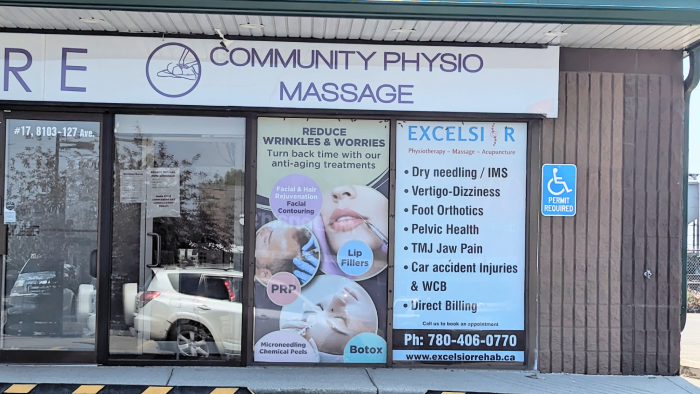MEDICATIONS FOR ARTHRITIS
Home » CERVICAL SPINE ANATOMY
UPPER BACK ISSUES
Physiotherapy services in Edmonton to treat Upper Back and Neck issues
A hearty welcome to the readers of Excelsior Physiotherapy's online information resource on Cervical Spine issues.
It is important to stay aware of the major parts present in your neck and the way they function to help you take care of yourself when any neck issue arises. Two major anatomic terms used related to your neck are anterior or neck's front part and posterior or neck's back part. The spine part that controls the neck movement is known as the cervical spine. So, your neck's front part is referred to as the anterior cervical region while the back part is known as the posterior cervical area.
This online informative guide provides an elaborate general overview of your neck's anatomy. This section contains information on:
- Important parts present in your neck
- The functions of your neck's parts
SIGNIFICANT NECK STRUCTURES
Cervical Spine Anatomy
The significant parts present in your cervical spine are located below:
- Spinal segments
- Nerves
- Muscles
- Bones and joints
- connective tissues
This section of our informative resource stresses the significant structures of your neck based on specific categories.
Bones and Joints
Your spine consists of 24 bones known as vertebrae. These vertebrae have a stacked structure one above the other to create the spinal column. This spinal column helps your body to maintain upright structure with support.
Spine
From C1 to C7, the first seven vertebrae form the cervical spine. Your cervical spine begins from the starting point of connection of the top vertebra (C1) towards your skull's bottom. The slight curve of your cervical spine remains in inward position and C7 lies atop your thoracic spine near your chest.
Cervical Spine
Your skull's base is located on C1 which is also referred to as atlas. Two sturdy arches of bone with a wide hole at the middle of the atlas to accommodate your brain and skull. Unlike other vertebrae, the atlas features bigger bone projections on all sides.
Atlas
The atlas is located over the C2 vertebra also referred to as the axis. There is a big bone knob atop axis known as the dens. The structure of dens is pointed upwards and fits inside the atlas hole perfectly. The axis joints provide optimum support to your neck for turning left and right.
Axis
Every vertebra consists of same parts. C2 to C7 are the major part in every cervical vertebra, featuring circular block of bone known as the vertebral body. A bone ring runs towards the backside of your vertebral body consisting two parts. Dual pedicle bones are located just behind vertebral body. Dual lamina bones connect with pedicles to form a ring-like shape. The bones of lamina become the bony ring’s external rim. The stacking of vertebrae one above the other, causes a hollow like structure around the spinal cord. The laminae serve as a shielding roof for your spinal cord.
Cervical Vertebra
At the junction of the two lamina bones at the rear of the spine, a bony bump protrudes. You can feel these protrusions, known as spinous processes, by running your fingers up and down the back of your spine. The spinous process of C2 is the largest bump close to the top of your spine. You'll feel a different sizable spinous process at the base of the neck, where the cervical and thoracic spines merge. It's C7.
Spinous Processes
There are two bony protrusions on either side of each vertebra in the spine, one on the left and one on the right. Transverse processes are the name for these bony outgrowths. Of all the cervical vertebrae, the atlas possesses the widest transverse processes. The neck vertebrae are different from the rest of the spine in that each transverse process has a hole that runs through it. This opening, known as the transverse foramen, serves as a conduit for arteries that travel up each side of the neck and bring blood to the back of the brain. Facet joints refer to the two joints located between each pair of vertebrae. The neck can move in a variety of directions because to the sliding motion of the joints that hold the vertebrae in a chain together.
Facet Joints
Articular cartilage protects the top layer of your facet joints. The majority of joints have a seamless rubbery covering on their ends. It makes it possible for bones to move smoothly and without friction against one another. Each vertebra has a tiny passageway known as a neural foramen on its left and right sides. The foramina are where the two nerves exit the spine at each vertebra. Directly in front of the aperture is where the intervertebral disc is located. Narrowing of the aperture and pressure on the nerve might result from a bulged or herniated disc. In the foramen's back is a facet joint. The tunnel may get smaller and the nerve may become pinched if bone spurs that develop on the facet joint protrude into it.
Neural Foramen
Nerves
The spinal cord is encased as it travels through the spine by a hollow tube created by the bony ring on the back of the spinal column. The spinal cord, which is made up of millions of nerve fibers, resembles a lengthy wire. The spinal column's bones guard the spinal cord in a manner similar to how the skull guards the brain.
Spinal Cord
Through the spinal column, the spinal cord descends from the brain. Each vertebra has two big nerves that emerge from the spinal cord, one on the left and one on the right. The neural foramina serve as a conduit for the nerves. The primary nerves that travel to the limbs and organs are made up of these spinal nerves. The arms and hands are supplied with nerves by the cervical spine.
Connective Tissues
Strong connective tissues called ligaments hold bones to one another.
- The front of the vertebral bodies is lengthwise stitched together by the anterior longitudinal ligament.
- Within the spinal canal, two more ligaments span the entire length.
- The posterior longitudinal ligament is connected to the vertebral bodies at the back.
- The front surface of the lamina bones is joined by a long, elastic band called the ligamentum flavum.
- Connective tissue also makes up the intervertebral disc, a unique form of structure found in the spine.
- TCollagen cells, which are specific cells, create the fibers of the disc.
Two Parts of Intervertebral Disc
A disc between the vertebrae has two components. The nucleus, or core, is spongy. The majority of the spine's shock absorption is provided by it. The annulus, a network of sturdy ligament rings around the nucleus, keeps it in place.
Muscles
The muscles that cover the anterior cervical region extend from the rib cage and collarbone to the cervical vertebrae, jaw, and skull. The majority of the tissues on the back of the neck are composed of the posterior cervical muscles, which cover the bones along the back of the spine.
Spinal Segment
- Two vertebrae divided by the intervertebral disc constitute every spinal segment, along with the nerves that exit the spinal cord at every vertebra and the tiny facet joints that connect each vertebra within the spinal column.
- The two vertebral bodies of the spinal segment are divided by the intervertebral disc. Normally, the disc functions as a shock absorber.
- It shields the spine from gravity's daily pull. Additionally, it safeguards the spine when engaged in strenuous actions like lifting, sprinting, and jumping.
- The facet joint joins the spinal segment together.
- The cervical spine's facet joints cooperate to bend and rotate the neck.
Summary
The anatomy of the neck is made up of numerous significant components. You may take an even greater part in your health care and be more prepared to treat your neck issue if you have an understanding of the areas and structures of the neck.






